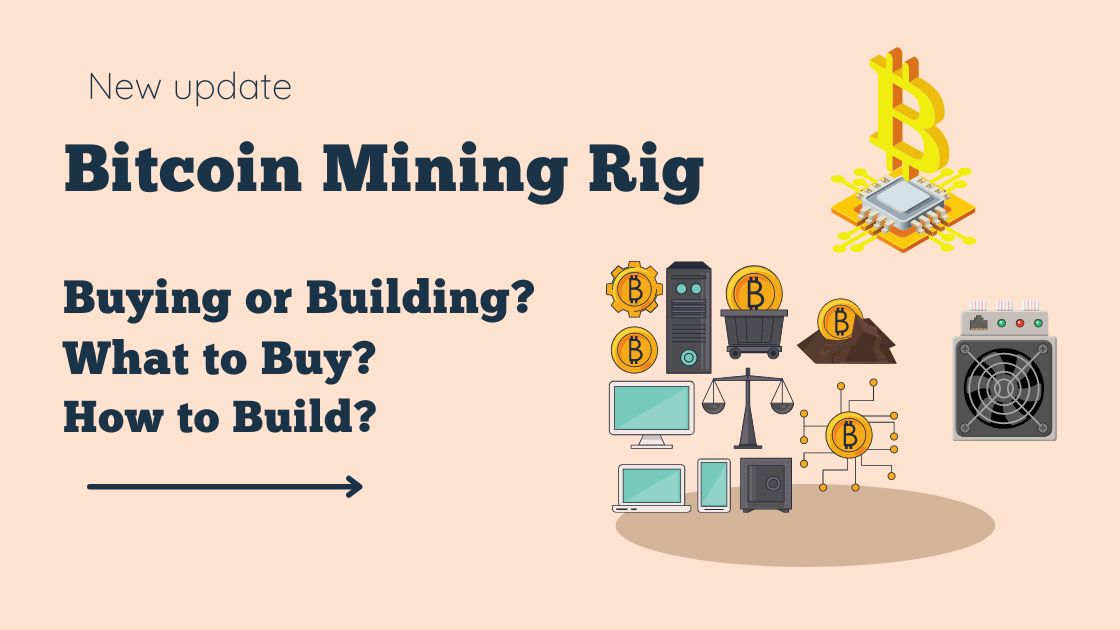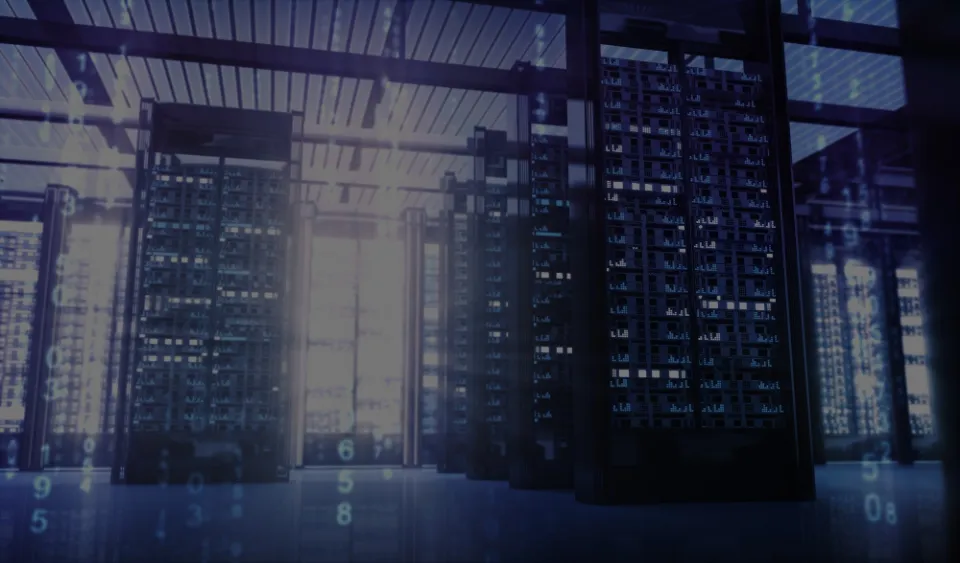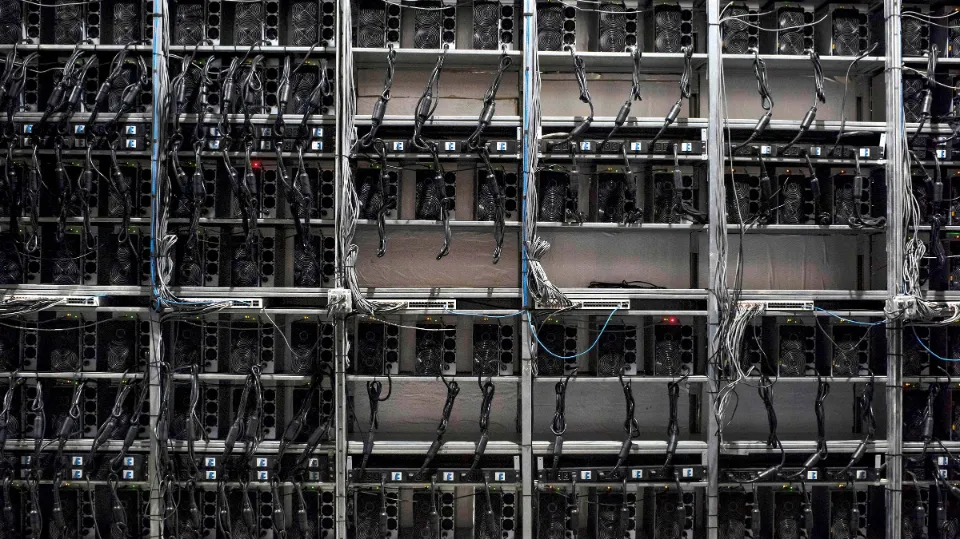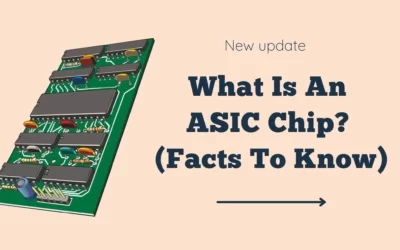In this article, we cover everything you need to know about Bitcoin mining rigs and how you can get started with mining rigs more profitably.
Many different types of miners, from small home miners to large publicly traded companies, mine bitcoin and other cryptocurrencies each year for millions of dollars. According to research by The Block, bitcoin miners earned $15 billion in revenue in 2021.
If you have affordable electricity and the best and most effective Bitcoin mining hardware, mining bitcoins as a hobby can be enjoyable and even profitable.
What is a Mining Rig?
A computer designed specifically for mining cryptocurrencies is known as a mining rig. A Proof-of-Work (POW) algorithm cryptocurrency uses a miner to process transactions and secure the network. To be the first to produce a new block of transactions that can be added to the blockchain, a mining rig continuously performs hash operations.
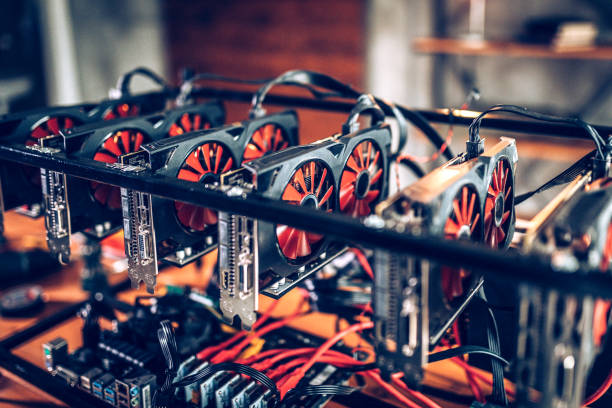
Out of all PoW-based cryptocurrencies, mining rigs are most frequently used for Bitcoin, which has over 99% of the market share in computing power backing it. The hashrate is not directly transferable between all of these cryptocurrencies due to the fact that some of them employ different hashing algorithms.
A mining rig typically has dozens of parts and hundreds of chips. These are all set up to mine cryptocurrencies with the highest level of energy efficiency.
Key Highlights:
- Mining rigs are specialized computers, customized for cryptocurrency mining
- A miner is used to help process transactions and secure the network of a cryptocurrency that uses a Proof-of-Work algorithm
- There are various kinds of mining rigs, including CPU miners, GPU miners, and ASICs. These are best suited for different cryptocurrencies
Types of Mining Rigs
Since Bitcoin first appeared, a variety of mining rigs have gained popularity. Manufacturers continue to push the boundaries of what is practical in order to increase efficiency and, consequently, profitability because mining has historically been profitable. The various mining rig types are examined below, along with how they have impacted the mining sector over time.
What is a CPU Miner?
The CPU (Central Processing Unit), which is a component of every personal computer, is where mining begins. This kind of miner was exclusively used in the early days of Bitcoin. On the other hand, computers are versatile tools. They are not tuned for a single kind of calculation to be the most energy-efficient possible. It is frequently said that mining from a personal computer is no longer profitable because as mining competition increased, CPUs were quickly outperformed.
What is a GPU Miner?
A computer built specifically to mine cryptocurrencies is known as a GPU mining rig. The GPUs (Graphics Processing Units) are typically connected to the motherboard of what may appear to be a typical personal computer. It therefore has a lot more mining power than a CPU. The first GPU mining rigs debuted in 2009 and offered a 332% increase in efficiency over CPU miners.
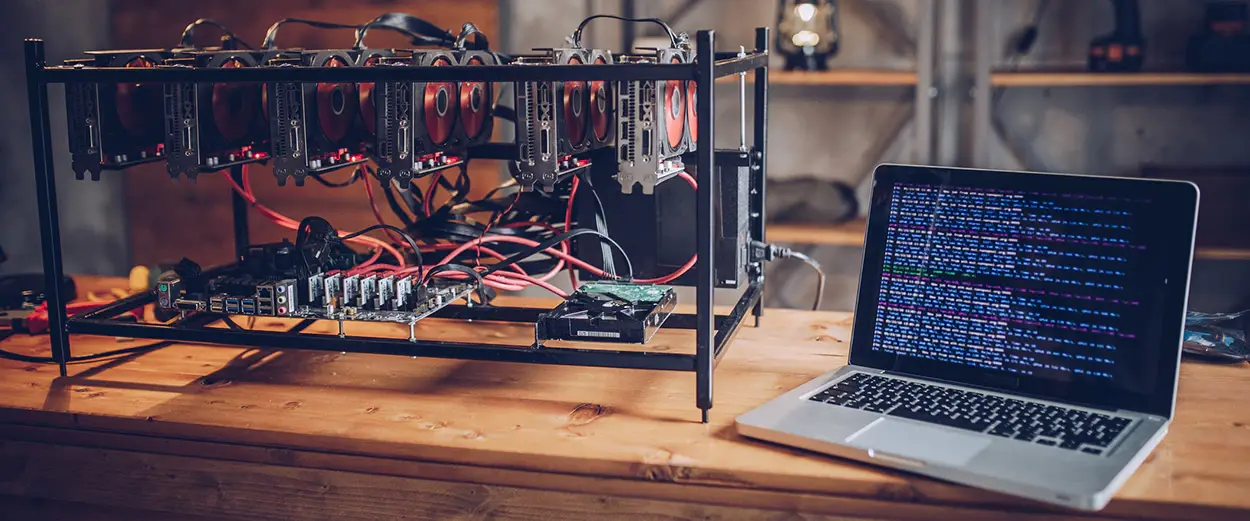
GPUs are not made with cryptocurrency mining in mind. They are used in many different applications, such as machine learning, rendering for graphics and video, and gaming.
Companies like Nvidia, Asus, MSI, and AMD are among the most well-known GPU producers. Nvidia’s GeForce RTX 3060 Ti and GeForce 3090, as well as AMD’s RX 6700 XT and Radeon RX 580, are some of their most popular GPUs for mining.
The cryptographic equations required to validate transactions on a blockchain can be solved more effectively by GPUs. In terms of instructions per clock, a single high-end GPU can outperform a conventional CPU by up to 800 times. For anyone looking to mine cryptocurrencies, they are therefore crucial.
GPUs are a popular option for miners because they also have significantly higher hash rates and are simpler to maintain. It is possible to calculate the profitability of mining by looking at a computer’s hash rate, which is a measurement of how quickly it can solve cryptographic equations.
What is a FPGA Miner?
An electronic circuit known as a FPGA (Field-Programmable Gate Array) can be programmed to carry out particular tasks. Therefore, it can be set up to mine a particular cryptocurrency before being reprogrammed to mine a different one. Although this sounds great in theory, it is challenging to implement and FPGAs use more energy than ASIC miners. This also explains why they are not used much for mining anymore.
The first FPGA mining rigs were 615% more energy-efficient than GPU miners in 2011.
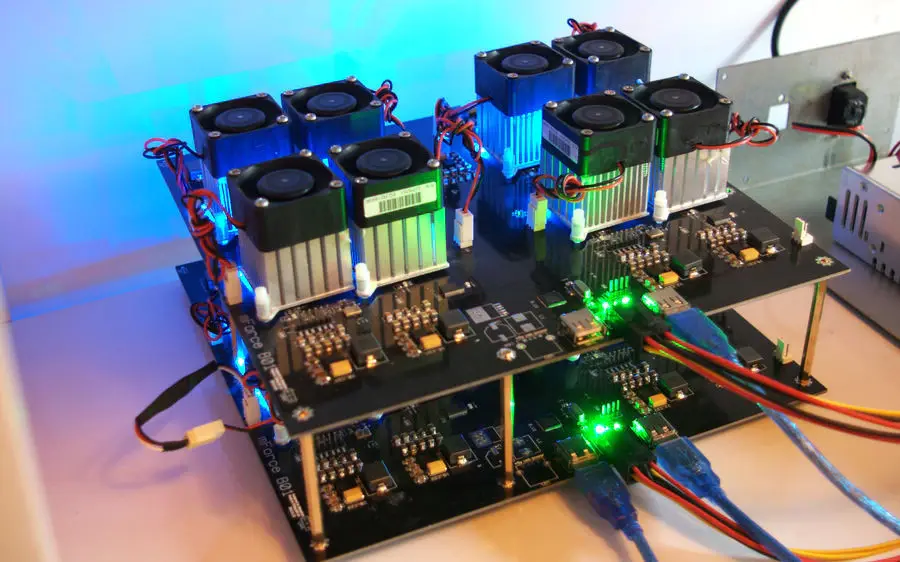
What is An ASIC Miner?
ASICs, or Application-Specific Integrated Circuits, are currently the most common mining equipment. This processing unit, in contrast to the others, is a chip made specifically for the application in question rather than for general use. Mining is one of these unique applications. An ASIC will have power efficiency that is far superior to other computers when it is designed with mining in mind. Since ASICs are required for this, it is impossible to compete with ASIC mining rigs without them.
In comparison to FPGA miners, the first ASIC mining rigs from 2013 used 460% less energy.
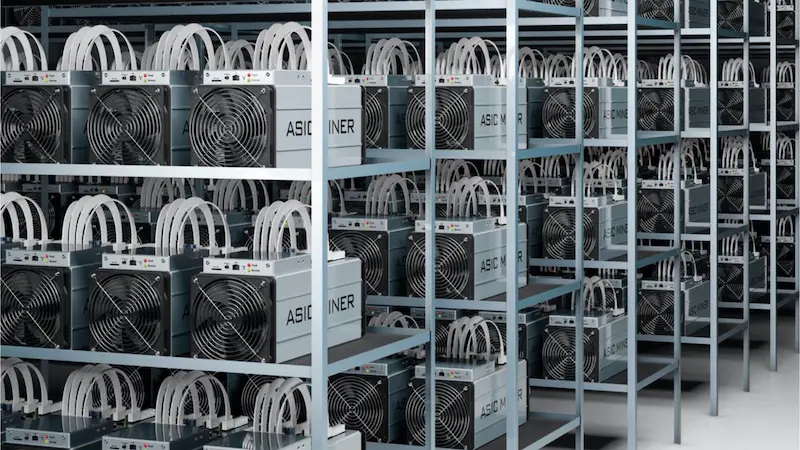
Which Mining Rig for Which Cryptocurrency?
The various kinds of mining rigs are typically used to mine various Proof-of-Work cryptocurrencies. This match depends on the algorithm used to secure the blockchain of each respective cryptocurrency. It is unprofitable to use specific kinds of mining rigs due to some of these algorithms.
Some things to consider when looking to build a bitcoin mining rig are:
- Equipment costs must be taken into account because GPUs and ASICs can be pricey pieces of hardware.
- Electricity prices: Since mining cryptocurrency requires a lot of energy, it is important to take electricity prices into account.
- Building a mining rig can be a trial-and-error process that requires a lot of tweaking and adjusting; it’s not like building a custom PC.
Some cryptocurrencies are best suited for ASICs, making it unprofitable for CPUs and GPUs to compete for block solving. People without money may find it challenging to mine profitably as a result of the higher cost of ASICs.
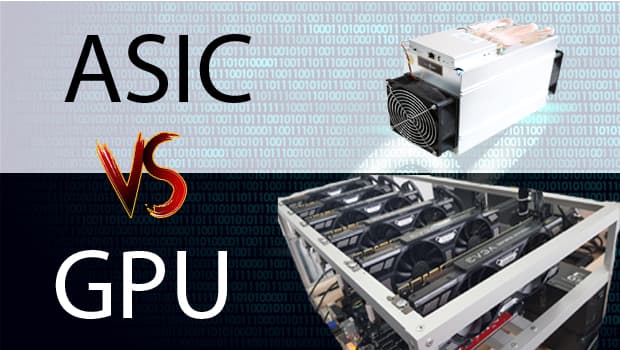
Other cryptocurrencies try to be ASIC-resistant to keep mining accessible at lower price points for more people. There are some drawbacks to this approach as well:
- It puts a lot of pressure on the GPU market when mining rigs that use GPUs are the best option for a particular cryptocurrency, as is the case with Ethereum or Zcash. It becomes more challenging for people to find GPUs at reasonable prices for other applications, like the previously mentioned machine learning ones.
- When CPUs are the optimal mining rigs, such as in the case of Monero, there is a new incentive for hackers to infect as many computers as possible to make them mine cryptocurrency at no cost for the hacker. Prior to the development of CPU-based cryptocurrency mining, making money from a significant number of compromised computers required more effort.
How Much Does a Mining Rig Cost?
A typical ASIC mining rig may cost between $2,000 and $20,000. That is a wide range and does not fully convey the caliber of the product.
It’s critical to realize that there are other considerations to take into account when purchasing a miner other than the mining rig’s price. An operator seeks to operate miners that are as efficient as possible given their financial commitment.
Cost vs Energy-Efficiency
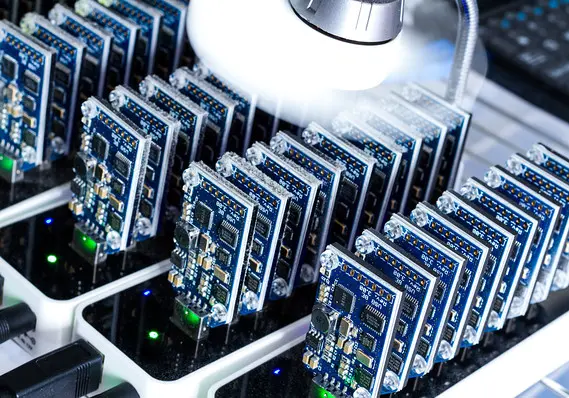
The cost vs energy-efficiency tradeoff is different for cryptocurrency mining than it is for other devices, equipment or machines, where a premium is often paid for a disproportionately low improvement in performance or features. For instance, a laptop does not become 20% better at everything when its price is raised by 20%.
For a miner, if the cost is 10% greater than that of another rig, the efficiency should be 10% greater as well. Alternatively, it might be more advantageous to invest that capital in a different mining rig with a higher dollar-to-efficiency ratio.
The efficiency of older miner generations is typically lower than that of newer ones. It may still be profitable to mine with older miners, depending on the cost of a cryptocurrency and how hard it is to mine it. The abundance of inexpensive energy in the area is another factor, as it enables business owners to buy less efficient machines and make up the difference with the cost of energy.
Buy Or Build a Mining Rig?
The steps involved in building a mining rig mostly apply to GPU mining rigs, which need to have various components purchased, assembled, and configured. More technical understanding is needed for this. Setting up a single GPU mining rig can take up to three hours, even for someone with extensive knowledge in the subject. For someone new to mining, the duration would likely be many times that.
However, since the ASIC mining rig is designed specifically for mining, it will work best right out of the box. Even though there is no assembly required, setting up and running a mining operation still requires work.
How Much Can You Earn With One Mining Rig?
It is challenging to provide a straightforward answer, such as $5–$10 per day, because the profitability of a mining rig depends on a number of variables. Profitability in mining is determined by a miner’s revenue minus operating expenses.
The costs in the mining sector are typically split into two groups: capital expenditures and operating expenditures.
CapEx in mining:
- Costs associated with the infrastructure, cabling, auxiliary equipment, and mining rigs, as well as delivery fees.
- Cost of the facility if the operator owns it, otherwise this is OPEX.
OpEx in mining:
- electricity needed to keep the mining operation operating.
- replacement parts and tools for maintaining mining equipment
- the facility’s costs, should one be rented.
- Staff wages.
- business administration.
- Costs associated with security and/or insurance.
- Regulations and possible licensing requirements.
- the cost incurred by the operator for joining the mining pool.
In addition to costs, there are also factors that can potentially decrease mining revenue:
- Miner delivery time.
- Installation delays.
- Miner downtime.
- an increase in the difficulty of mining.
- OPEX costs are frequently covered by payments made in fiat money, which results in a decline in the value of the cryptocurrency that is mined.
Calculating Break-Even for Mining
The seller of a mining rig should ideally offer statistics that enable the operator to figure out when their investment will break even. After the operational costs have been paid, any money that is still left over is profit.
Because mining rig manufacturers are unable to predict in advance how difficult it will be to mine new blocks in months or years from now, they must make estimates, which is why this is a range rather than a specific number.
Even if there isn’t a calculator but there is an estimate of when a return on investment can be anticipated, it is still advisable to confirm this prediction in several different locations. Around the world, electricity prices vary greatly. A miner may be able to recover their investment in one location in a year, whereas the same miner in an area with high electricity costs may never turn a profit. Instead of using a predetermined value, the electricity cost in the estimation must always be updatable.
How to Find the Best Bitcoin Miner
There are some important factors to look at when determining which Bitcoin mining ASIC to buy:

- Hash rate – How many hashes can a Bitcoin miner produce per second? Efficiency is essential because more hashes are more expensive.
- Efficiency – The most effective bitcoin mining equipment is what you should purchase. The Halong Mining Dragonmint T1 is currently displayed here. Since miners consume a lot of electricity, you should purchase one that generates the most bitcoins per unit of electricity.
- Price – What is the price of a bitcoin miner? Efficiency and electricity consumption are crucial because mining with cheap hardware will result in a reduction in bitcoin production. The fastest and more efficient mining hardware is going to cost more.
Don’t try to purchase a miner based solely on price or hash rate. The most productive ASIC bitcoin miner is also the best.
Looking at the highest efficiency, in relation to the cost, is a quick and dirty way to identify the best mining rig currently in use.
In actuality, efficiency per dollar is not always the best metric because not every mining operation is best suited for every setting. Some models call for different transformers, panels, breakers, and wiring locally, which would raise your overall costs. In order to maximize your use of the energy source you have available, you may want to consider other models with higher hashrates relative to their size.
How Long Does a Mining Rig Last?
History shows that some miners have a higher failure rate than others. For instance, the failure rates of the Antminer S17 and T17 were between 20 and 30 percent after a month. Some models from the same manufacturer, such as the Antminer S9, have been reliably running for over 6 years. When comparing various models, it’s crucial to take a machine’s durability into account.
It’s important to consider reliability and usability in addition to durability. Whatsminer has received a lot of praise for being a miner that is dependable and simple to use, which is crucial for large-scale mining operations.
It is wise for a buyer to conduct due diligence while keeping in mind that negative reviews frequently garner the most attention online.
Using a Mining Profitability Calculator
Making an educated choice about which miners to purchase requires using a mining profitability calculator because the cost of mining equipment fluctuates frequently. This calculator needs accurate information on some contemporary miners in order to function.
Read More: Is Bitcoin Mining Profitable?
Mining Rigs Compared
We have compiled a list of some of the more well-known mining equipment produced since 2020 below. Be aware that some of the hashrate values could, in reality, differ by a few percent.
A mining rig’s efficiency is calculated by dividing its wattage usage by its hashrate. This calculation’s efficiency increases as the result becomes less extreme. The cost of each machine varies. Even though one machine might be the most effective, it most likely has a high cost per Terahash. This is a crucial element that needs to be assessed.
Legend:
- Hashrate (TH/s): relates to the amount of trillions of hash functions that a miner can complete in a single second.
- Watts (W): relates to how many Watts of power a miner needs to use to complete that many hashes per second.
- Efficiency (J/TH): relates to the energy used to complete one trillion hash functions. The lower this number, the higher the efficiency of a mining rig. (In this equation, the “per second” portion cancels out, and Watts and Joules can be compared 1:1.
| Model | Manufacturer | Release date | Hashrate | Watts | Efficiency |
|---|---|---|---|---|---|
| Whatsminer M50 | MicroBT | Apr 2022 | 114 TH/s | 3306 W | 29.0 J/TH |
| Bonanza Mine 2 | Intel | Feb 2022 | 135 TH/s | 3510 W | 26.0 J/TH |
| Antminer S19 Pro Hydro | Bitmain | Jan 2022 | 198 TH/s | 5445 W | 27.5 J/TH |
| Antminer S19j Pro | Bitmain | Aug 2021 | 104 TH/s | 3068 W | 29.5 J/TH |
| Antminer S19j Pro | Bitmain | Jun 2021 | 100 TH/s | 3050 W | 30.5 J/TH |
| Avalonminer 1246 | Canaan | Jan 2021 | 90 TH/s | 3420 W | 38.0 J/TH |
| Whatsminer M30s++ | MicroBT | Oct 2020 | 106 TH/s | 3286 W | 31.0 J/TH |
Buying a Mining Rig
Given that a high-quality mining rig can cost thousands of dollars or more, it’s critical to comprehend the key factors to consider before making a purchase.
Power Efficiency
Electricity should be efficiently converted into hashes by a mining rig. This means that a mining rig’s power efficiency must also be taken into account in addition to the price point. The amount of electricity required to calculate a trillion hashes serves as a measure of efficiency.
Efficiency = watt / terahash
For instance, the most recent Antminer S19 XP uses 3010W of power and has a 140TH/s hashrate. Therefore, its efficiency is 3010W / 140 TH/s = 21.5J/TH. The efficiency increases with this number because it requires less energy to calculate a trillion hash functions.
Efficiency is an important metric because if a miner costs 5% less but produces 10% less hashrate, the rig is less effective than competing models. As a result, less effective models may eventually be permanently phased out of the market when profit margins become negative, while mining rigs that are more effective can continue to operate for a longer period of time.
Manufacturer Reputation
If someone is considering purchasing a mining rig, they should confirm that it was made by a reputable company with a proven track record.
Since the advent of ASICs, a number of companies have made claims that their mining rigs could achieve a specific hashrate, but the rigs either never materialized or performed below expectations.
List of Bitcoin ASIC Manufacturers
Not every item on this list is included. It only includes producers who have released a new model in the previous two years.
- Bitmain
- MicroBT
- Canaan
- Intel
the majority of the active Asia is home to ASIC producers. In order to avoid lengthy shipping times and unforeseen delays, this may make it more appealing for people on other continents to buy their mining rigs from brokers or service providers.
Timing the Mining Market
Research, development, and innovation are ongoing, just like with any other technology. New generations of miners get to market every year, with higher energy efficiency than the older generations. These new miners have an impact on the price and long-term viability of older generations of mining equipment. It is crucial to remember that newer miners do not eject older ones from the market right away or quickly.
It would be prudent for an operator to conduct some research and project when a new generation of miners may arrive if they are interested in purchasing a large number of mining rigs. Although the adoption of new miners won’t be widespread right away and their acquisition may be challenging, the impact could be significant for a large-scale mining operation.
A further consideration is the cost of the cryptocurrency that the mining rig can mine in addition to the manufacturing market. Mining rig values may fluctuate in tandem with this price. There is typically more profit to be made from mining when the cryptocurrency price rises significantly, as the price of mining rigs doesn’t move as fast. Since price forecasting is a notoriously challenging task, it is best to think long term rather than short term.
Where to Buy a Mining Rig?
There are four places to buy a mining rig:
- From a manufacturer, note that these sometimes have large order minimums and potentially long shipping times due to geographical location.
- From a broker, which buys and sells miners as a business model. Brokers typically buy from a big wholesaler or the manufacturer.
- A full-service provider can assist in hosting or co-locating miners to lessen all of the operational difficulties associated with running a mining operation. With our Mining product, River is one such service provider.
- originating from a secondary market where peers can trade used mining equipment.
Buying a Second Hand Mining Rig
Purchasing used mining equipment is a situation in which caution is especially advised. The lower cost of used miners can be alluring, but it’s crucial to make sure that they are in the condition that was described.
Generally speaking, purchasing used mining equipment is a secure option. Although mining rigs are typically operational around-the-clock, it is in the seller’s (the original miner) best interest to take reasonable care of the machinery to preserve its resale value. Because efficiency is their top priority, miners don’t risk their safety by mistreating machinery and then trying to get rid of it before it breaks.
It is still recommended to exercise caution due to the size of the investment required to purchase mining equipment. Here are some of the aspects to look out for when buying second-hand mining equipment:
- Reputation of the reseller – This is a significant consideration, just like when purchasing any used equipment. A marketplace with some kind of buyer protection can also be taken into account to help guard against dishonest sellers.
- Did the miners ever malfunction and require repairs? – There are occasional breakdowns among miners. Similar to fixing any other electronic device, proper repairs call for industry knowledge. It can reduce a mining rig’s longevity and, consequently, the return on investment if done incorrectly as a result of human error.
- What has the past performance been like? – In order to check that the numbers match what is advertised, savvy customers may request images and details on the performance history of the hashrate. Even though it isn’t yet the norm, advocating for it would greatly increase industry transparency and could even mean the difference between making a profit and losing money.
Bitcoin Mining Hardware Companies
- Bitmain – The AntMiner line of Bitcoin miners is produced by Bitmain. Bitmain is based in Beijing, China and also operates a mining pool.
- MicroBT – Based in Shenzhen, MicroBT is another producer of ASIC miners in China. Their WhatsMiner line is a serious rival to Bitmain’s AntMiner lineup.
- Canaan – The first ASIC miner for Bitcoin that was sold commercially was created by Canaan. Canaan produces Bitcoin mining equipment as well as a number of blockchain tools and enterprise solutions.
Components Required to Build a Mining Rig
A customized mining rig that contains components: a CPU, motherboard, RAM and storage, etc. These include:
GPUs
GPUs are the essential part of any mining rig, as was previously stated. Depending on the hash rate one wants to achieve, a certain number of GPUs will be required. For a beginner, however, one or two GPUs should be adequate.
ASICs
ASICs are specialized devices made just for mining cryptocurrencies. They usually come with a higher price tag than GPUs, but offer much higher hash rates.
Motherboard
A mining rig’s motherboard functions as the foundation of all computers. All of the GPUs that will be used in the rig must be supported by it.
CPU
Some beginners choose to mine with CPUs alone, which is also possible. However, they must be sophisticated and able to meet mining demands. A basic mining rig only requires a low-end or moderate CPU, such as an Intel 8th or 9th generation, when using GPUs.
Ram
Any computer needs random access memory (RAM), which is used to temporarily store data while the machine is operating. It’s critical for a mining rig to have enough RAM to store the data from all of the GPUs it uses.
Power Supply Unit
The power supply unit (PSU) is one of the most important components in a mining rig. This is due to the fact that the PSU must be able to power all of the equipment’s components adequately. As a general rule, choose a power supply unit (PSU) that can deliver at least twice the power that your system will require. A PSU with a 1200w platinum rating will typically perform well.
Storage
A mining rig needs some storage, just like any other computer. This could take the shape of an SSD or a hard drive. How much data you plan to mine will determine the storage size. Normally, any drive that is 240 GB or bigger should work.
Other Requirements
There are a few additional items required in addition to the hardware parts mentioned above to construct a mining rig. These include:
- Mining software such as CGMiner, EasyMiner or BFGMiner;
- An operating system such as Awesome Miner, Rave OS or Hive OS;
- A crypto wallet to store your mined coins;
- A riser to elevate your GPU for increased airflow;
- A stable internet connection; and
- A flash drive with at least 5GB capacity.
How to Build a GPU Mining Rig for Beginners
It’s time to assemble a crypto-mining rig now that we’ve talked about the parts needed. Below is a quick step-by-step guide:
Step 1: Attach the Motherboard
Verify that the lever holding the socket for your CPU is in the released position. The motherboard should then be set on top of something that will prevent static electricity from affecting it, such as a foam box or an anti-static bag, outside of the mining frame.
Step 2: Attach the Processor
Connect the motherboard to the processor. To help you remember which one is which later, mark the CPU and motherboard sockets with a mark. Additionally, exercise caution when connecting the CPU pins to the motherboard because they have a tendency to bend easily and harm the entire processor.
Step 3: Install the RAM
It is very simple to insert a RAM module into a motherboard’s RAM socket. Open the side brackets of the motherboard slot and carefully push the RAM module into the RAM socket. The RAM must be installed in the proper orientation, and caution must be used because the RAM may only lock into the socket in one direction.
Step 4: Attaching the PSU
To prevent the mining rig from not starting, make sure the PSU is firmly connected to the motherboard. The motherboard slot closest to the processor on the CPU should receive the 8-pin power connector.
Step 5: Attaching USB Risers
The GPUs must be connected to the motherboard using these. Put them into the motherboard’s accessible PCI slots.
Step 6: Attaching GPUs
Secure the GPUs onto the frame by using USB risers. Connectors for the GPUs’ PCI-e 6+2 power are then inserted. Before starting the mining rig, make sure all the cables are plugged in correctly. It’s ready to begin mining for cryptocurrencies once everything has been plugged in.
How to Set Up a Mining Rig
This section will go over the steps involved in setting up a mining rig and, more generally, a mining operation. If this seems like too much work, keep in mind that there are other options where you only provide the miners with capital and other parties handle setup and maintenance. Customers can take advantage of this service from River Financial. By doing this, you can benefit from Bitcoin mining’s rewards without the hassle or complexity (often at a scale that individuals would not be able to achieve on their own).
Setting Up a Mining Operation
There are more steps than just plugging in a device, pressing a button, and entering a few parameters into an interface when it comes to starting a mining operation. There are more factors to take into account as an operation grows. For this reason, it’s beneficial to first zoom out and consider the overall business plan.
Location for a Cryptocurrency Mining Operation
The location is a critical decision, here are a few reasons why it is not an afterthought:
Noise – It is crucial to take into account the fact that mining rigs are very loud if a small-scale operation with just one or a few at home is the plan. A single mining rig will typically generate between 40 and 85 decibels of noise, which is too loud for a residential area.
Cooling – Additionally, mining rigs get very hot from constantly running at high performance. A mining rig cannot simply be insulated to reduce noise because they need cooling, which means they must be cooled. The heat also means that operating a facility in an area where it is already hot may result in higher cooling costs for the mining rigs.
Energy – Beyond what it costs to cool them, mining rigs themselves consume a lot of energy. A mining rig should never blow the fuses while it is operating, no matter where it is. An energy-starved mining rig won’t be able to turn a profit over time if it doesn’t receive enough power to operate at maximum efficiency.
Some miners have advanced their operations in terms of creativity by using the heat produced by their rigs to support other commercial endeavors.
To conclude, a good location for a mining operation needs to:
- Support high levels of power usage.
- get a hold of a dependable, quick internet connection.
- Allow enough room for people to move around, as well as the mining rigs, cooling equipment, and people.
These variables must be carefully considered and planned so as to enable the operation’s expansion, if that is the goal.
There may be other factors that affect a mining operation in addition to these fundamental requirements.
Legality, Licensing, and Regulations
Various rules and laws pertaining to mining may be applicable depending on the miner’s jurisdiction. Only a few nations, some of which require miners to obtain licenses, have laws that specifically address mining as of 2022.
Insurance and Security
Due to the value of mining rigs, it is wise for an operator to get insurance to protect against theft and potentially against natural disasters.
It is insufficient to simply purchase insurance. If mining rigs would get stolen, it would not just be the machines that are gone, but also the potential income they should be earning until they would be replaced. The time it takes to recover the cost of the operation’s investment in a mining rig can occasionally be extended by lengthy delivery times. To reiterate the significance of selecting a good location, it is crucial to make sure that the area where the miners are located has thorough security.
The emphasis shifts to setting up the hardware and software once the more significant difficulties related to the operating location have been resolved.
Setting Up Mining Hardware
ASIC miners come with setup instructions, just like any other electronic device. These provide thorough instructions for assembling a mining rig.
There are already a number of hardware-related things that can be planned for before the mining rigs are delivered.
Placement of Mining Rigs How to position the miners for cooling and accessibility for potential repairs is a crucial factor to take into account. The industry standard is to use a frame, rack, or case for this. For large-scale operations, containerized solutions are even used so that hundreds of mining rigs can be moved quickly at once.
Cable Management One essential component is power cables. Because there are so many different plug standards used around the world and mining is a worldwide phenomenon, many manufacturers choose not to include a power cable with the rig. It follows that power cords must be ordered in advance. There is information provided by manufacturers about the appropriate cables to buy.
Furthermore, it is crucial to adhere to the 80% rule in general when using electrical appliances. This indicates that only about 80% of the total amperage can be handled by circuit breakers. The equipment could be damaged if the number was exceeded.
Remember that mining rigs use Ethernet/LAN cables in addition to power cables since these are more reliable than WiFi. One Ethernet cable is required for each mining rig, and it’s generally a good idea for an operator to have a few extra cables on hand for the rigs to minimize potential downtime.
Read More: How To Build An ASIC Miner 2022
Setting Up Mining Software
The firmware, also known as the mining software, is frequently pre-installed on ASICs. The manufacturer internally developed this closed-source firmware. In contrast to what can be unlocked and accomplished with open-source mining software, it frequently has restricted functionality.
In general, it is advised to consider using different mining software because the default mining software may occasionally reduce a miner’s productivity in order to prevent novice users from damaging their equipment and blaming the manufacturer.
Thankfully, there is a wide variety of open-source mining software on the market, frequently available for no cost to the user.
List of Bitcoin mining software:
- ASICSeer
- Awesome Miner
- BFGMiner
- Braiins OS
- CGMiner
- EasyMiner
- ECOS
- Foreman
- Kryptex Miner
- Minder
- MSKMiner
- MultiMiner
- Vnish
The stratum mining communication protocol, port number, potential username, and the mining pool the rig should join all need to be configured after the mining software has been installed.
Read More:
Connecting a Wallet to a Mining Rig
Any wallet or address the operator has access to can receive coins mined from it. Both custodial and non-custodial arrangements are effective. Since nearly all miners will sign up for an existing mining pool, this pool will ask the operator to which address it should send its portion of the revenue.
Joining a Mining Pool
Recall that the purpose of mining pools is to provide miners with a consistent source of revenue. An operator’s chances of finding a block and recovering their investment are extremely slim when mining without a pool. Smaller but more frequent returns can be made by teaming up with other miners in a big enough pool.
It is advisable to weigh your options before deciding which bitcoin mining pool to join. In addition to charging a fee ranging from 0-4%, pools may pay out to members at various intervals. It’s critical to read the fine print when the fee is 0% because there usually is a justification. Operators may also receive additional services from a pool, including improved monitoring, a mobile app, an API, the ability to tailor payouts to specific requirements, and more.
Read More: How To Join A Bitcoin Mining Pool
The 10 biggest Bitcoin mining pools as of 2022 are:
- Foundry USA
- AntPool
- F2Pool
- Binance Pool
- Poolin
- ViaBTC
- BTC.com
- Luxor
- SlushPool
- SBI Crypto
Once a mining pool is selected, all the necessary information to join the pool will be available on the pool’s website. These steps include connecting a wallet, configuring the miners to work for the selected pool, and entering the Stratum URL into the mining software to set up the communication protocol.
Final Thoughts: Find an Effective Bitcoin Mining Rig
Nowadays, mining bitcoins at home has almost become impossible.
In addition to being costly, the equipment also uses a lot of electricity and produces a lot of heat and noise.
It is uncomfortable and nearly impossible to turn a profit because of this!
Meanwhile, setting up a single GPU mining rig can take up to three hours, even for someone with extensive knowledge in the subject. For someone new to mining, the duration would likely be many times that.
If you have affordable electricity and the best and most effective Bitcoin mining hardware, mining bitcoins as a hobby can be enjoyable and even profitable.
The Bitcoin network is stronger the more evenly distributed hash power is!
begincoinmining.com is a website where you can find a lot of insightful information on Bitcoin mining. Leave a comment!
FAQs

Is CPU Mining Still Relevant?
CPU mining is obsolete for mining BTC and many large-cap PoW blockchains. Such circumstances prevent CPU miners from using electricity as effectively, and their hash power prevents them from competing with other mining rig options.
Kilohashes per second (kh/s), which equal 1,000 hashes, are the units used to express CPU chip mining. Only a small number of the fastest CPUs (as of 2021) surpass the 20 kh/s limit, with the majority of them operating at 8 to 20 kh/s. These figures are insignificant in light of those other mining rig types.
Is It Worth Building a Mining Rig 2022?
So, yes, it is definitely worth building a cryptocurrency rig in 2022! You (most likely) were one of those people who didn’t choose to mine BTC back in 2010, so you don’t even need to try to put yourself in their shoes!
How Much Does a Mining Rig Make a Day?
Daily Profit = (2,250 Dollars Per Year) x 365 Days Per Year = $727.5 Per Day. To mine 1 Bitcoin over the course of a year, assuming a mining rig costs around $8,000, you will need to invest roughly $8,000. In a few years, mining will still be extremely profitable. In fact, we think the business will be even more successful than it is now.
Do Mining Rigs Use a Lot of Internet?
The short answer is – very very small amount of internet bandwidth. Even for a medium- to large-scale mining farm, 5mbps would be sufficient. How much bandwidth a typical 6 x RX 580 Mining Rig uses in an hour was tested by Red Panda Mining in a fantastic video.
Do Mining Rigs Use a Lot of Electricity?
To begin with, mining rigs’ graphics cards are always in operation. That uses a lot more energy than just surfing the web. A rig with three GPUs can consume 1,000 watts of power or more when it’s running, the equivalent of having a medium-size window AC unit turned on.
Is It Worth Buying a Mining Rig Now?
Yes, mining is profitable in early 2022. The profit margin is, of course, based on the cost of the electricity you use. The profits increase as the price of electricity decreases. Above, you can see the current estimated profitability for 6 AMD RX 6800XT cards at a $0.15 electricity price.
How Many GB Do I Need for a Mining Rig?
RAM — Higher RAM does not mean that you get a better mining performance, so we recommend using anywhere between 4GB and 16GB of RAM. When determining which RAM size best suits your needs, consider the operating system for mining and whether or not virtual memory is employed.
How Long Should You Run Your Mining Rig?
The average lifespan of a well-kept, maintained machine can be around 3 to 5 years. ASICs can, however, degrade in as little as a few months if they are kept in harsh or subpar conditions. An ASIC miner’s lifespan, however, can be increased by more than 5 years by taking good care of it.
How Much Does a Bitcoin Mining Rig Make a Day?
In February 2022, one Bitcoin mining machine (commonly known as an ASIC), like the Whatsminer M20S, generates around $12 in Daily bitcoin earnings are based on bitcoin price.

